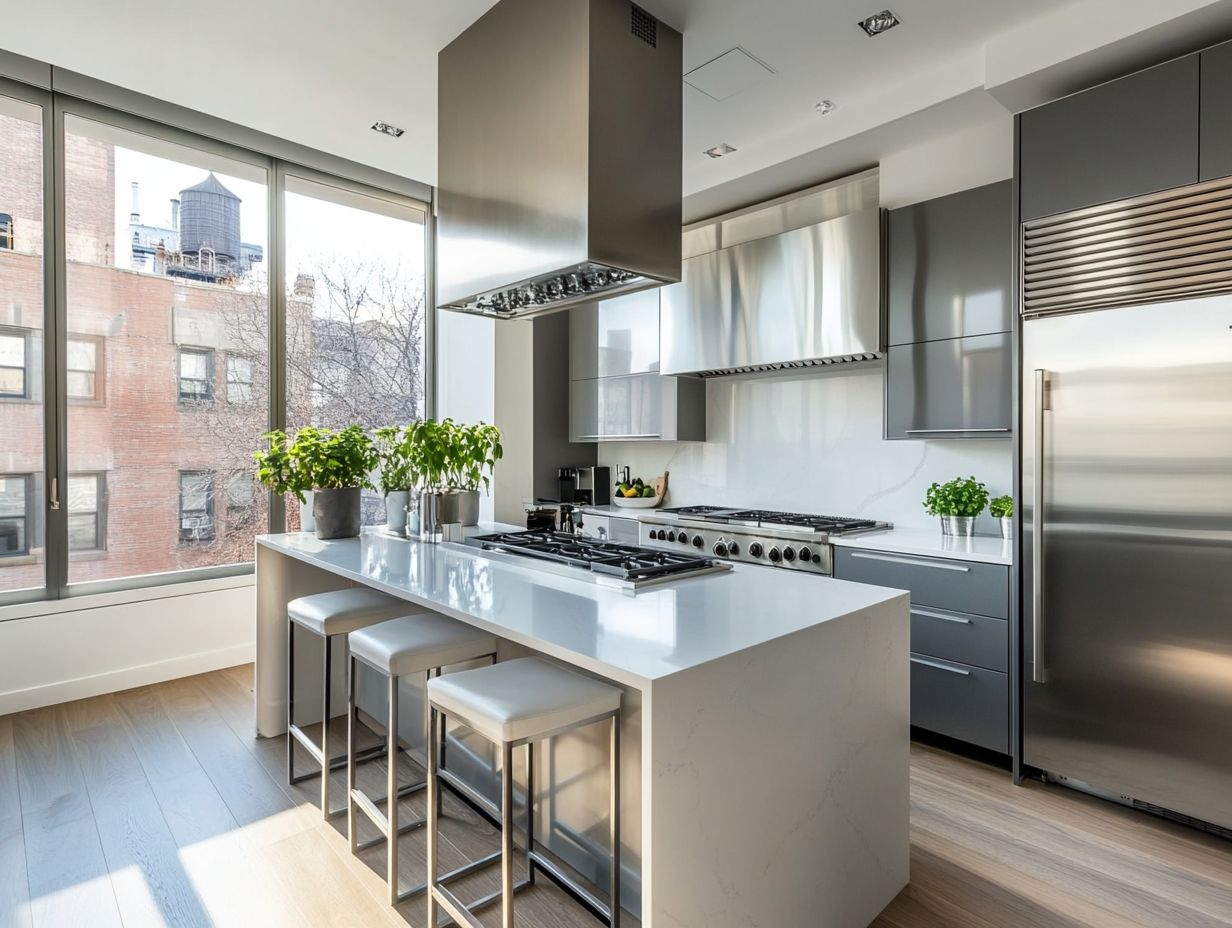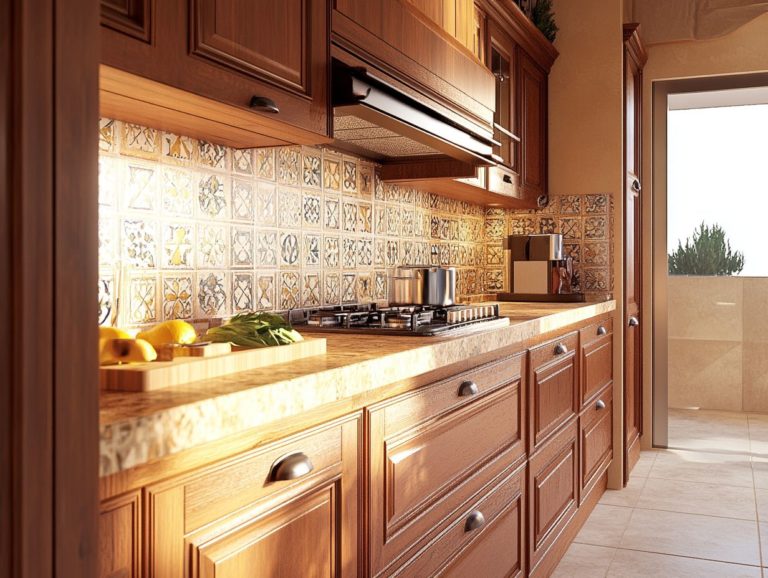How to Combine Functionality and Style in Kitchen Design
In today’s fast-paced world, your kitchen transcends mere functionality; it becomes the very heart of your home, where practicality intertwines with style.
Crafting a kitchen that is both visually stunning and seamlessly operational requires a thoughtful balance of layout, storage, and lighting.
Let’s explore the key factors you should consider in your kitchen design, from embracing trendy elements to optimizing space and appliance efficiency.
You’ll also discover inspiring examples that elegantly showcase the art of blending practicality with aesthetic charm, guiding you toward realizing the kitchen of your dreams.
Contents
- Key Takeaways:
- The Importance of Kitchen Design
- Factors to Consider in Kitchen Design
- Incorporating Style into Kitchen Design
- Maximizing Functionality in Kitchen Design
- Combining Functionality and Style
- Examples of Successful Kitchen Designs
- Frequently Asked Questions
- How do I effectively combine functionality and style in my kitchen design?
- What are some functional design elements that can also enhance the style of my kitchen?
- Can I still have a stylish kitchen if I have a limited budget for renovations?
- How can I make sure my kitchen design is both functional and stylish for my specific needs?
- Are there any color schemes or design styles that are best for combining functionality and style in a kitchen?
- Can I still add personal touches to my kitchen design while maintaining functionality and style?
Key Takeaways:
- Create a functional and stylish kitchen by considering layout, storage, and lighting.
- Incorporate design elements and trends to add style to your kitchen.
- Maximize functionality by efficiently using space and appliances, finding the balance between beauty and practicality.

The Importance of Kitchen Design
Kitchen design plays a pivotal role in your home, significantly impacting both functionality and aesthetics. It’s an essential consideration for any homeowner.
A well-planned kitchen layout promotes efficient traffic flow and makes cooking more enjoyable. Stylish elements—like durable countertops and strategically placed cabinets—enhance the overall design.
Whether you prefer an open-plan kitchen or a more traditional setup, your choices in materials, colors, and fixtures should reflect your personal style and meet your culinary needs. This creates a harmonious space that seamlessly integrates with your living area, making your kitchen a true reflection of you.
Creating a Functional and Stylish Space
To achieve a functional and stylish kitchen, strike a balance between practicality and aesthetics. Every element should serve a purpose while contributing to the overall design theme.
Smart storage solutions reduce clutter and boost style, while comfortable seating invites family and friends to gather, fostering a warm atmosphere.
Incorporating kitchen islands serves as a central hub for meal prep and casual dining, seamlessly blending functionality with style. Choose stylish kitchen cabinets that maximize space and enhance beauty, transforming your kitchen into both a culinary haven and a stylish social gathering spot.
Factors to Consider in Kitchen Design
When embarking on a kitchen design project, several key factors significantly influence the effectiveness and allure of the space.
Consider the kitchen layout, storage options, and lighting solutions, as each plays a vital role in crafting a functional and inviting environment.
Layout, Storage, and Lighting
An effective kitchen layout, paired with intelligent storage solutions and the right lighting, can elevate your cooking experience by enhancing both functionality and ambiance.
Explore various kitchen designs—U-shaped, L-shaped, and galley layouts—each with its own set of advantages that influence how you utilize space and manage workflow. For example, a U-shaped kitchen offers generous counter space and ample storage, perfect for larger families or those who love to entertain.
A galley kitchen, a narrow layout with appliances and counters lining up on either side, fosters efficiency and ensures everything you need is within arm’s reach while optimizing traffic flow.
Thoughtful organization, such as using vertical cabinets for pots and lids in an L-shaped layout, maximizes your storage potential. Coupled with strategically placed lighting in key areas, you enhance visibility, transforming your cooking space into an enjoyable environment.
Incorporating Style into Kitchen Design

Incorporating style into your kitchen design means carefully selecting the right elements and staying attuned to current trends. This approach crafts an inviting and visually appealing space that truly reflects your unique taste.
Design Elements and Trends
Design elements and contemporary trends are essential in crafting the look of your kitchen. Kitchen cabinets and countertops are fundamental components that set the stage for the overall style.
In today’s design landscape, open shelving enhances practicality and adds a stylish touch. It allows you to showcase beautiful dishware while creating an inviting sense of spaciousness.
Bold colors—ranging from deep emerald greens to vibrant yellows—infuse energy, transforming your kitchen into a lively gathering spot. Innovative textures, like matte finishes and mixed materials, bring depth and intrigue to surfaces.
Integrating these trends requires thoughtful consideration of functionality. Ensuring that open shelves remain accessible while enhancing visual appeal creates a harmonious balance between form and practicality.
Maximizing Functionality in Kitchen Design
Maximizing functionality in your kitchen design is essential for cultivating an efficient cooking environment.
This requires thoughtful space planning and strategic appliance placement. Streamlining your cooking process elevates your culinary experience.
Efficient Use of Space and Appliances
The efficient use of space and appliances is essential for a well-designed kitchen. Every square foot should be thoughtfully utilized to enhance your cooking and dining experiences.
Prioritizing space efficiency means incorporating smart storage solutions that take advantage of vertical space and under-counter areas. Imagine pull-out shelves and deep drawers making everything accessible.
Your appliances should embrace the work triangle concept. This means positioning your refrigerator, stove, and sink in a triangle formation to make cooking easier. To maximize usability, consider compact, multifunctional appliances—like countertop gadgets that can blend, chop, and juice all in one.
Choosing models that combine these functions saves precious space while enhancing convenience. This makes your kitchen a delightful place to create and enjoy meals.
Combining Functionality and Style
Incorporating both functionality and style in your kitchen design is paramount for crafting a space that is as beautiful as it is practical.
Achieving this balance ensures that your kitchen serves daily needs while reflecting your personal style.
Finding the Balance

Finding the balance between functionality and aesthetics in kitchen design is a nuanced process. It demands thoughtful decision-making and creative problem-solving skills.
As you embark on this journey, consider how various design elements interact with your everyday use. Evaluate your kitchen layout; an open-concept design promotes flow and accessibility, but it might lack distinct zones.
Prioritize storage solutions that blend seamlessly with your style. Elegant cabinetry can provide ample space for utensils and cookware.
Select durable materials that withstand the test of time while enhancing overall visual appeal. Choose fixtures like sinks and faucets that combine elegance with functionality, making sure they enhance your kitchen’s look without sacrificing practicality.
Examples of Successful Kitchen Designs
Dive into inspiring kitchen designs that spark your creativity! You’ll discover how various layouts, cabinetry, and countertops can harmoniously blend to create a space that is functional and aesthetically pleasing.
Ready to transform your kitchen? Let’s get started today!
Real-Life Inspirations
Real-life inspirations can guide your kitchen design choices, showing how various layouts and materials come together to elevate both functionality and aesthetic appeal.
As you explore different real-life kitchens, you’ll encounter a rich tapestry of design elements that address the practical demands of daily life while also satisfying your desire for visually stunning environments.
Consider open layouts that connect cooking and dining spaces, or the careful selection of durable countertops designed to endure everyday wear and tear. Each detail is essential.
Innovative storage solutions, like pull-out shelves and islands that serve multiple purposes, enhance organization and accessibility. This demonstrates that function and form can coexist in perfect harmony.
Explore real-world kitchens to see how design choices create beautiful, user-friendly spaces.
Frequently Asked Questions
How do I effectively combine functionality and style in my kitchen design?
The key to combining functionality and style in kitchen design is to find a balance between the two. This can be achieved by carefully selecting functional features that also add visual appeal, such as a statement backsplash or a multifunctional island.
What are some functional design elements that can also enhance the style of my kitchen?

Some functional design elements that can add style to your kitchen include pull-out shelves, built-in appliances, and custom storage solutions. These features transform your kitchen into a stylish haven while boosting practicality!
Can I still have a stylish kitchen if I have a limited budget for renovations?
Absolutely! You can create a beautiful and functional kitchen design even with a limited budget. Consider opting for affordable yet stylish materials, such as laminate countertops and vinyl flooring.
You can also utilize DIY projects or shop for secondhand items to save on costs.
How can I make sure my kitchen design is both functional and stylish for my specific needs?
When designing your kitchen, it’s important to consider your specific needs and preferences. For example, if you love to cook, prioritize functional features like ample counter space and a well-equipped pantry.
If you enjoy entertaining, focus on creating a welcoming and stylish space for guests.
Are there any color schemes or design styles that are best for combining functionality and style in a kitchen?
The best color schemes and design styles for combining functionality and style in a kitchen depend on personal preference and the overall aesthetic of your home. However, neutral colors, such as white, gray, and beige, are always a safe choice as they can complement any style.
Can I still add personal touches to my kitchen design while maintaining functionality and style?
Yes, incorporating personal touches in your kitchen design adds character and makes it feel like a true reflection of your style. Just be sure to keep it balanced with functional elements.
For example, you can display decorative items on open shelves while keeping essential kitchen tools hidden in cabinets.





